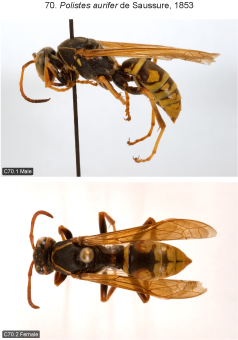
| Home | Table of contents | Keys | Species list | Glossary | Image data | PDF | Cite this article | Feedback | Updates |
Identification Atlas of the Vespidae (Hymenoptera, Aculeata) of the northeastern Nearctic region
CJAI 05, February 19, 2008
doi: 10.3752/cjai.2008.05
Matthias Buck, Stephen A. Marshall, and David K.B. Cheung
Department of Environmental Biology, University of Guelph, Guelph, Ontario, Canada N1G 2W1
Next species | Previous species | Key
70. Polistes aurifer de Saussure, 1853
Figs B10.58; C70.1–5.

|

|
Species recognition. This western Nearctic species is closely related to P. fuscatus and has until recently been treated as a subspecies of the latter (Richards 1978). In both sexes it is distinguished from P. fuscatus by the ferruginous dorsal surface of flagellomere 1 and sometimes also the following flagellomeres (more or less darkened in P. fuscatus), by the more yellowish wings, and by the presence of yellow discal spots on tergum 2 (often confluent with apical fascia; the spots rarely present in P. fuscatus females, uncommon in P. fuscatus males).
Variation. Size as in P. fuscatus. Specimens from the northern part of the range are usually black, marked richly with yellow, and have very restricted ferruginous markings; some southwestern forms possess a largely yellow metasoma. Specimens from certain areas of the southern U.S. and northwestern Mexico are largely ferruginous with almost no black markings and moderately to well developed yellow markings.
Distribution. Canada: AB and BC; according to Starr (1991) possibly also in MB and SK (records not clearly distinguished from P. fuscatus; see Distribution under that species); adventitious in PE (1 ♀, Summerside, November 1973; CNCI). Western U.S.: WA and MT south to western TX and CA. Northeastern Mexico: Baja California, Sonora, Chihuahua, and Coahuila. Introduced in Hawaii and Society Is. (Carpenter 1996a).
Biology. Nests in sheltered situations (Krombein 1979).
Next species | Previous species | Key
| Home | Table of contents | Keys | Species list | Glossary | Image data | PDF | Cite this article | Feedback | Updates |
